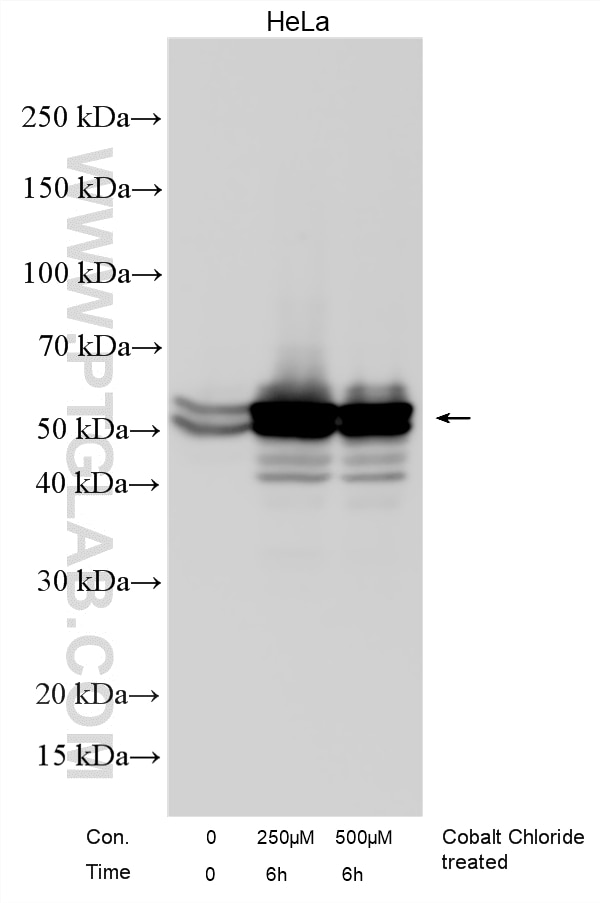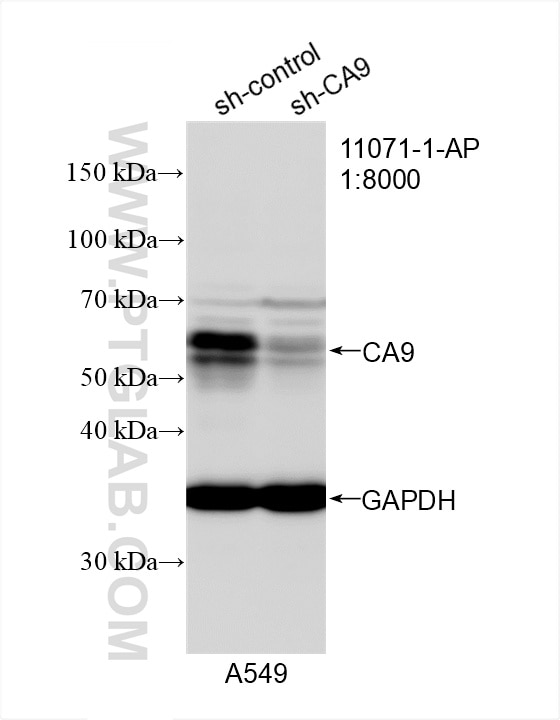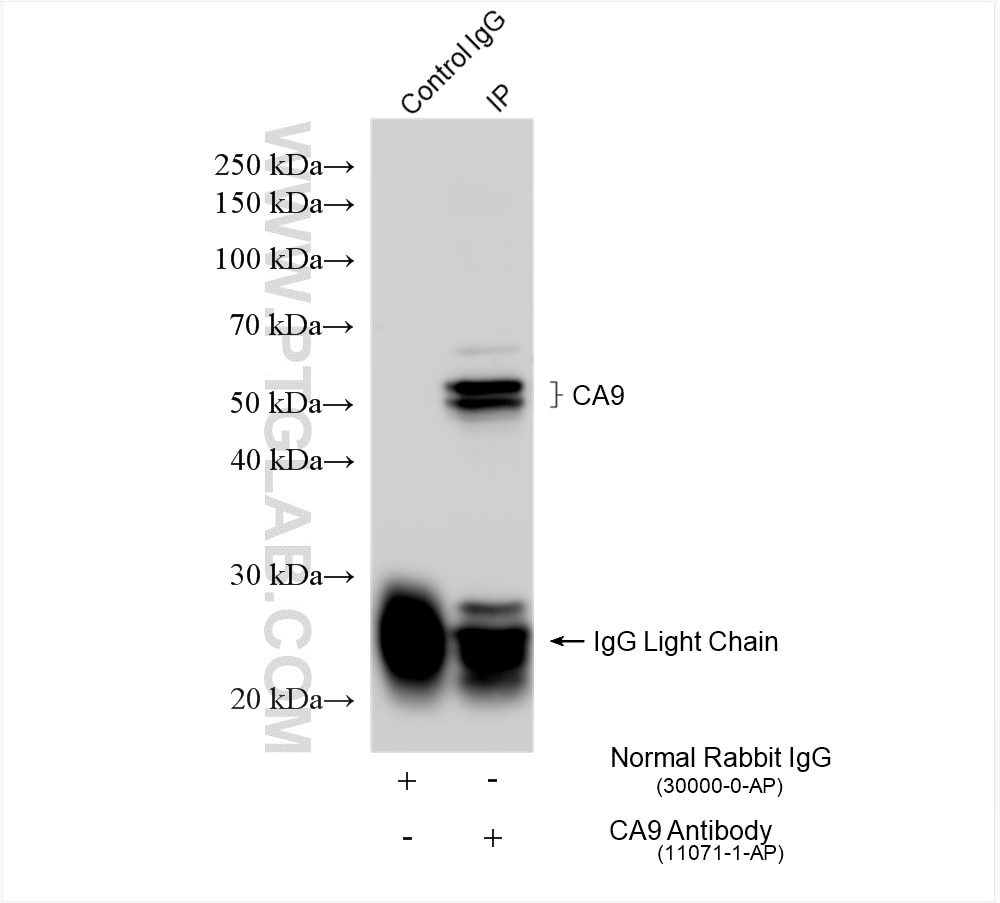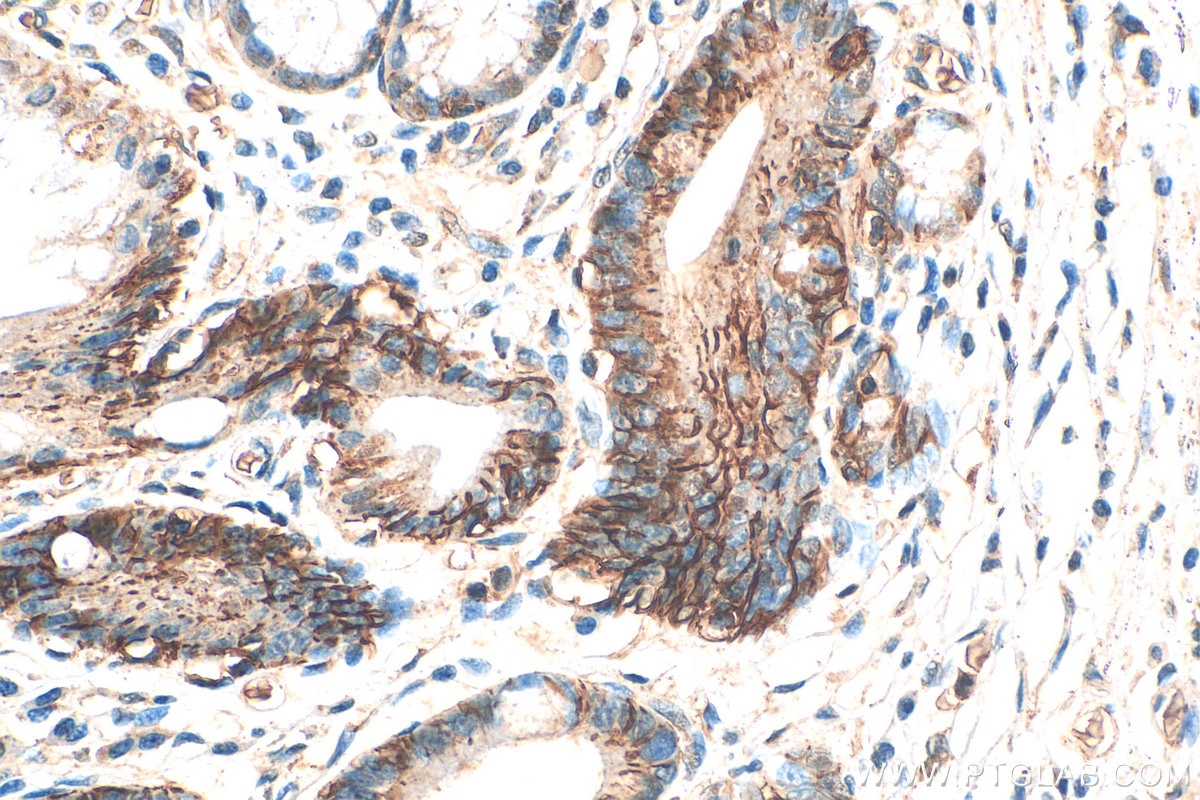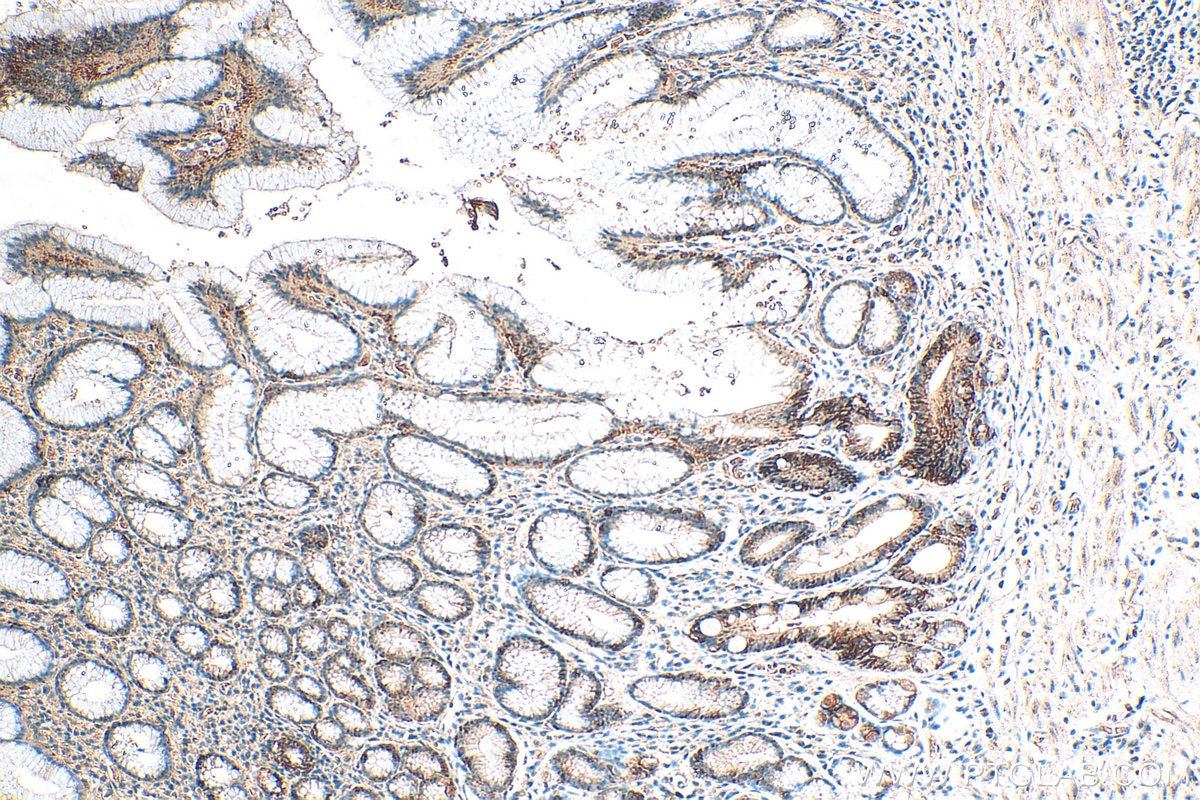- Featured Product
- KD/KO Validated
Carbonic Anhydrase IX/CA9 Polyklonaler Antikörper
Carbonic Anhydrase IX/CA9 Polyklonal Antikörper für WB, IHC, IP, ELISA
Wirt / Isotyp
Kaninchen / IgG
Getestete Reaktivität
human, Maus, Ratte
Anwendung
WB, IHC, IF, IP, ELISA
Konjugation
Unkonjugiert
Kat-Nr. : 11071-1-AP
Synonyme
Geprüfte Anwendungen
| Erfolgreiche Detektion in WB | A549-Zellen, mit Cobaltchlorid behandelte HeLa-Zellen, HeLa-Zellen |
| Erfolgreiche IP | HeLa-Zellen |
| Erfolgreiche Detektion in IHC | humanes Magenkrebsgewebe Hinweis: Antigendemaskierung mit TE-Puffer pH 9,0 empfohlen. (*) Wahlweise kann die Antigendemaskierung auch mit Citratpuffer pH 6,0 erfolgen. |
Empfohlene Verdünnung
| Anwendung | Verdünnung |
|---|---|
| Western Blot (WB) | WB : 1:1000-1:6000 |
| Immunpräzipitation (IP) | IP : 0.5-4.0 ug for 1.0-3.0 mg of total protein lysate |
| Immunhistochemie (IHC) | IHC : 1:50-1:500 |
| It is recommended that this reagent should be titrated in each testing system to obtain optimal results. | |
| Sample-dependent, check data in validation data gallery | |
Veröffentlichte Anwendungen
| KD/KO | See 1 publications below |
| WB | See 24 publications below |
| IHC | See 27 publications below |
| IF | See 9 publications below |
Produktinformation
11071-1-AP bindet in WB, IHC, IF, IP, ELISA Carbonic Anhydrase IX/CA9 und zeigt Reaktivität mit human, Maus, Ratten
| Getestete Reaktivität | human, Maus, Ratte |
| In Publikationen genannte Reaktivität | human, Maus |
| Wirt / Isotyp | Kaninchen / IgG |
| Klonalität | Polyklonal |
| Typ | Antikörper |
| Immunogen | Carbonic Anhydrase IX/CA9 fusion protein Ag1540 |
| Vollständiger Name | carbonic anhydrase IX |
| Berechnetes Molekulargewicht | 459 aa, 50 kDa |
| Beobachtetes Molekulargewicht | 50 kDa, 60-70 kDa |
| GenBank-Zugangsnummer | BC014950 |
| Gene symbol | CA9 |
| Gene ID (NCBI) | 768 |
| Konjugation | Unkonjugiert |
| Form | Liquid |
| Reinigungsmethode | Antigen-Affinitätsreinigung |
| Lagerungspuffer | PBS with 0.02% sodium azide and 50% glycerol |
| Lagerungsbedingungen | Bei -20°C lagern. Nach dem Versand ein Jahr lang stabil Aliquotieren ist bei -20oC Lagerung nicht notwendig. 20ul Größen enthalten 0,1% BSA. |
Hintergrundinformationen
CA9 (Carbonic anhydrase 9) may be involved in the control of cell proliferation and transformation and appears to be a novel specific biomarker for a cervical neoplasia (PMID:18703501). It is a tumor-associated antigen that has been shown to have diagnostic utility in identifying cervical dysplasia and carcinoma. The protein is present in the cytoplasmic membrane and the nucleus, with a molecular weight of 50 kDa. The molecular weight of the glycosylated form is approximately 60-70 kDa. (PMID: 31142270, PMID: 31819036)
Protokolle
| PRODUKTSPEZIFISCHE PROTOKOLLE | |
|---|---|
| WB protocol for Carbonic Anhydrase IX/CA9 antibody 11071-1-AP | Protokoll herunterladen |
| IHC protocol for Carbonic Anhydrase IX/CA9 antibody 11071-1-AP | Protokoll herunterladenl |
| IP protocol for Carbonic Anhydrase IX/CA9 antibody 11071-1-AP | Protokoll herunterladen |
| STANDARD-PROTOKOLLE | |
|---|---|
| Klicken Sie hier, um unsere Standardprotokolle anzuzeigen |
Publikationen
| Species | Application | Title |
|---|---|---|
Proc Natl Acad Sci U S A CRLX101 nanoparticles localize in human tumors and not in adjacent, nonneoplastic tissue after intravenous dosing. | ||
Cell Commun Signal KCNJ2/HIF1α positive-feedback loop promotes the metastasis of osteosarcoma | ||
Biomed Pharmacother Para-toluenesulfonamide, a novel potent carbonic anhydrase inhibitor, improves hypoxia-induced metastatic breast cancer cell viability and prevents resistance to αPD-1 therapy in triple-negative breast cancer | ||
Oxid Med Cell Longev Carbonic Anhydrase IX Controls Vulnerability to Ferroptosis in Gefitinib-Resistant Lung Cancer | ||
Oxid Med Cell Longev Targeting the Ang2/Tie2 Axis with Tanshinone IIA Elicits Vascular Normalization in Ischemic Injury and Colon Cancer. | ||
Eur J Nucl Med Mol Imaging In vivo three-dimensional evaluation of tumour hypoxia in nasopharyngeal carcinomas using FMT-CT and MSOT. |
Rezensionen
The reviews below have been submitted by verified Proteintech customers who received an incentive for providing their feedback.
FH Aline Seiko (Verified Customer) (05-12-2025) | It was observed a 70kDa and 25kDa isoform.
|
FH Maelle (Verified Customer) (01-03-2025) | Lost efficacy after freeze-defreze even if it is in glycerol
|
FH Josh (Verified Customer) (10-28-2021) | 15 ug of human clear cell renal cell carcinoma cell line RCC4 was resolved on 15% Tris/Glycine and transferred to PVDF membrane. Membrane was blocked in blocking buffer (2% BSA in TBS/0.1% Tween-20) for 1hr at room temperature, followed by overnight incubation with anti-CA9 (1:1000) in blocking buffer at 4oC. After 1hr incubation with anti-Rabbit secondary antibody, membrane was imaged with ECL. Expected band was detected along with several non-specific bands by western blot
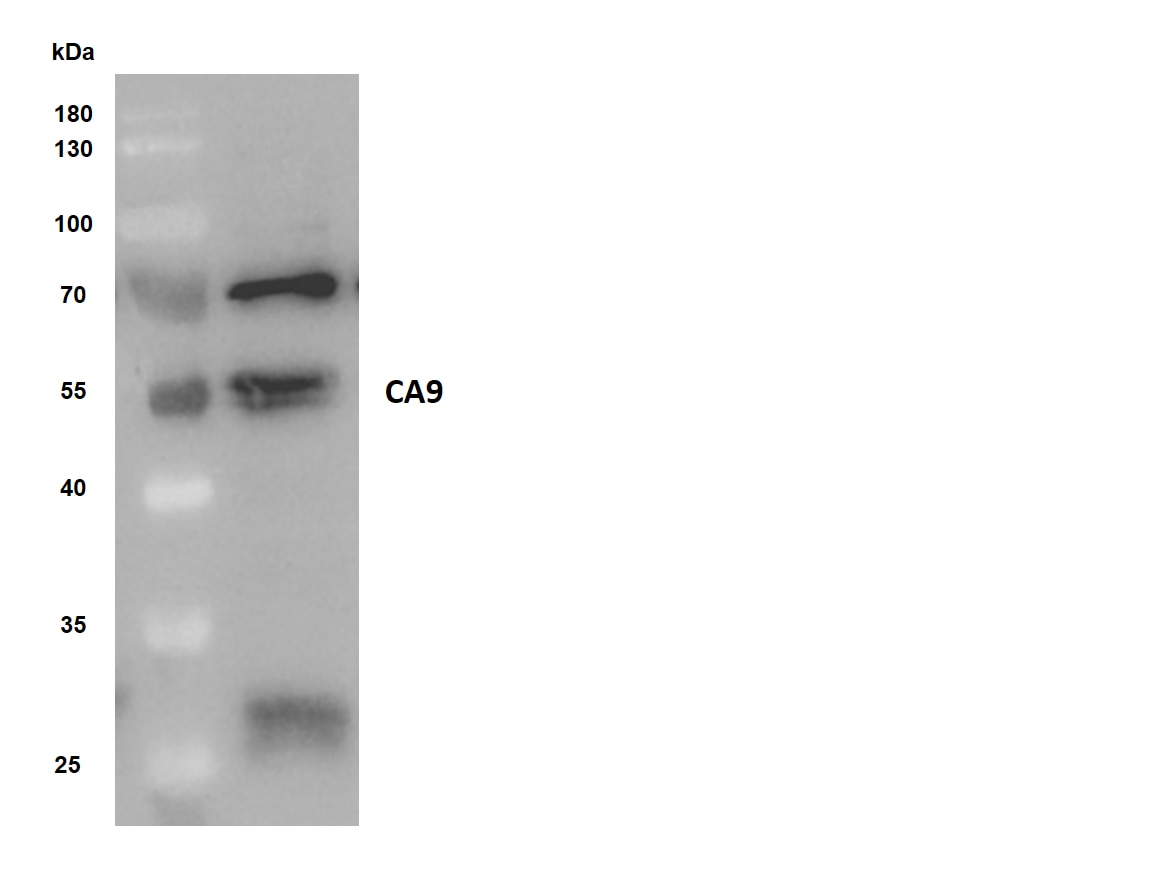 |
FH K (Verified Customer) (08-03-2021) | total cell lysate (50 ug of human HCC cell lines) was resolved on 10% Bis-Tris gel and transferred to nitrocellulose membrane. Membrane was incubated in blocking buffer (5% BSA in TBS/0.1% Tween-20) for 1h. Membrane was incubated with anti-CA9 in blocking buffer (1:500) at 40C overnight. After 1h incubation with appropriate secondary antibody (anti-Rabbit 1:5000) membranes were imaged with ECL and expected band was detected.
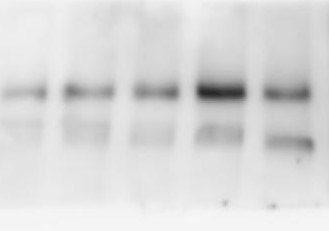 |
FH Paulo (Verified Customer) (03-04-2019) | Total cell lysate (50 ug of human ccRCC cell lines) was resolved on 10% Bis-Tris gel and transferred to PVDF membrane. Membrane was incubated in blocking buffer (5% milk in PBS/0.1% Tween-20) for 1h. Membrane was incubated with anti-CAIX in blocking buffer (1:250) at 4C overnight. After 1h incubation with appropriate secondary antibody (DAKO anti-Rabbit 1:10000) membranes were imaged with ECL and expected band was detected
|

